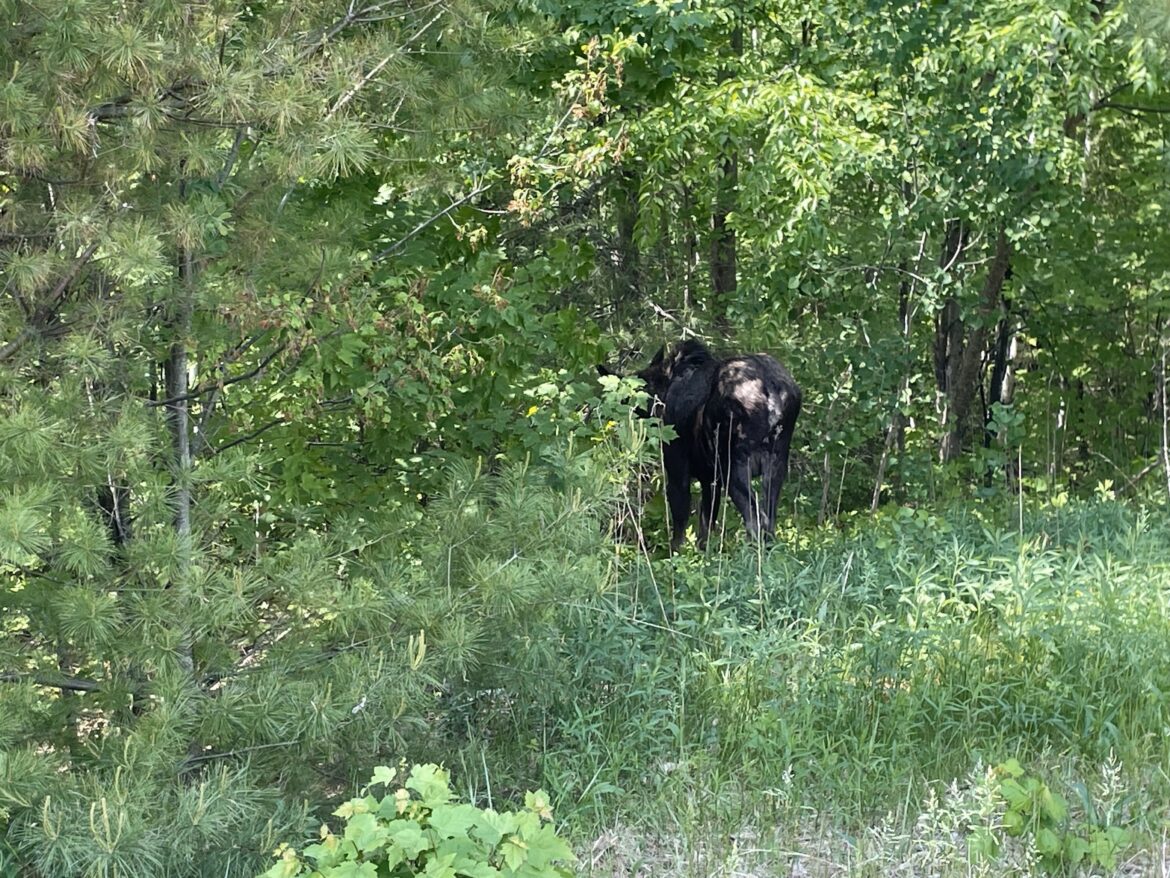By PAULA TRACY, InDepthNH.org
NORTH WOODSTOCK – Just off the exit ramp at Tripoli Road in the foothills of the White Mountains on Interstate 93 last June 1 where trucks, cars and motorcycles were zipping along, a moose was seen wandering on the off-ramp toward a steep, lush green hillside along the banks of the Pemigewasset River.
It was a rare sighting for the south side of the notch over the past decade as the number of moose has been on the decline.
Moose-human fatalities were a big thing around here in the 1990s when the population of behemoths was at their height for the century, but those have faded as the animals – particularly their young – have been ravaged, literally sapped dry by Winter Ticks.
The state’s 2023 population of moose is estimated at between 3,000 and 4,000.
In May, 1991 Howard C. Nowell, Jr., chief of the wildlife division at the New Hampshire Department of Fish and Game told the New York Times there were over 4,000 moose in the state and accidents between them and motorists had increased from 49 in 1985 to 170 in 1990.
In 2023, the state reported there were 45 collisions between moose and vehicles in New Hampshire and on average in the past five years about 68 collisions.
May should be considered moose month in the Granite State as they are more likely to venture toward the road, largely in search of salt and moving from their winter migration areas in the mountains down into the valleys.
The department has noted that while moose are active throughout the year, May through October are high-risk months for collisions because moose venture onto roadways to consume the remaining salt residue from winter surface treatments.
For the department it is time to again break out the “BRAKE FOR MOOSE! IT COULD SAVE YOUR LIFE” campaign of the 1990s, as they issued a press release warning drivers to slow down and live.
“Moose are an iconic species and a tremendous resource of our state, but it can be dangerous to encounter them on the road,” said New Hampshire Fish and Game Moose Project Leader Henry Jones.
“By following a few simple rules, motorists can greatly reduce their chance of a moose–vehicle collision or the severity of personal injury if they do hit a moose.”
The state’s iconic areas to see moose also still have the warning signs but don’t necessarily keep up with the number of fatalities as they used to.
Still, moose crave salt after a winter living in the high hills and mountains among spruce fir in the boreal forest, which is at its southern reaches in northern New Hampshire.
Their numbers grew rapidly from the 1960s through to the 1990s in large part because of a change in a more forested habitat, as the farms declined and early successional habitat from extensive logging set the table for attracting a solid population.
In recent years, the moose, which can grow to be more than 1,000 pounds and are in the same family as the deer, have seen their young die to parasites, due in part to milder winters.
The state initiated its first limited hunt of moose in the late 1980s as a management tool, the first time since the 1800s, and has slowly reduced the number of permits allowed. A lottery is open https://nhfishgame.com/2024/01/30/enter-the-2024-new-hampshire-moose-hunt-lottery-today/.
Last year, 5,950 entered the lottery for 33 permits, the fewest ever offered since the modern day lottery hunt began in 1988. In contrast, in 2007, 678 permits were issued at their height.
More data about the moose and the state’s objectives for management is here at the newly issued Harvest Summary https://www.wildlife.nh.gov/sites/g/files/ehbemt746/files/inline-documents/sonh/2023-harvest-summary.pdf
On May 27, 1991, the New York Times’ Fox Butterworth wrote “Comeback for Moose in New England Creates Road Hazard.”
It quoted the late former Coos County Democrat Publisher John Harrigan as saying the issue is one of education.
“I don’t blame the moose,” he said. “I fault the people who think they have a God given right to drive through the woods at 60 miles an hour.”
Fish and Game dusted off its Brake For Moose message this week and offered that when driving on New Hampshire roads, keep these points in mind:
– Moose and vehicle collisions happen statewide on all types of roads.
– Moose collisions occur most often from May through October.
– While collisions can happen at any time of day, they occur most frequently at dusk and at night.
– Moose can be up to seven feet high.
– Moose are dark brown, making them hard to see against pavement, especially at night.
– Don’t depend on “eye shine” (reflected light from headlights) to alert you to a moose’s presence; moose don’t always look at an approaching vehicle.
To reduce the chance of a collision–or the severity of occupant injury if you do hit a moose:
– Do not drive at high speeds
– Wear your seatbelt
– Scan the sides of the road
– Be able to stop within the zone of your headlights
– Use high beams whenever possible
– If you see a moose, slow down or stop if necessary, until you have passed it or it has left the road
Make sure your moose encounters are safe for you and the moose: Brake for Moose—It Could Save Your Life! Learn more at www.wildlife.nh.gov/wildlife-and-habitat/moose-new-hampshire/brake-moose.





